BOSTON : Electrical devices could soon be powered using ice-filled wires, thanks to MIT scientists including one of Indian origin, who have found that water can freeze solid even at high temperatures inside tiny carbon nanotubes.
Water starts to boil at a temperature of 100 degrees Celsius. Scientists have long known that when water is confined in very small spaces, its boiling and freezing points can change, usually dropping by abound 10 degrees Celsius.
Scientists, including Kumar Varoon Agrawal from Massachusetts Institute of Technology in the US, have found that water can freeze even at high temperatures that would normally set it boiling in carbon nanotubes whose inner dimensions are not much bigger than a few water molecules.
The discovery illustrates how even very familiar materials can drastically change their behaviour when trapped inside structures measured in nanometres, or billionths of a metre.
The finding might lead to new applications – such as, essentially, ice-filled wires – that take advantage of the unique electrical and thermal properties of ice while remaining stable at room temperature.
“If you confine a fluid to a nanocavity, you can actually distort its phase behaviour,” said Michael Strano, professor at MIT, referring to how and when the substance changes between solid, liquid and gas phases.
Such effects were expected, but the enormous magnitude of the change, and its direction (raising rather than lowering the freezing point), were a complete surprise.
In one of the tests, the water solidified at a temperature of 105 degrees Celsius or more.
The way water’s behaviour changes inside the tiny carbon nanotubes – structures the shape of a soda straw, made entirely of carbon atoms but only a few nanometres in diameter – depends crucially on the exact diameter of the tubes.
In the experiments, the nanotubes were left open at both ends, with reservoirs of water at each opening.
Even the difference between nanotubes 1.05 nanometres and 1.06 nanometres across made a difference of tens of degrees in the apparent freezing point, the researchers found. Such extreme differences were completely unexpected.
In earlier efforts to understand how water and other fluids would behave when confined to such small spaces, “there were some simulations that showed really contradictory results,” he said.
Part of the reason for that is many teams were not able to measure the exact sizes of their carbon nanotubes precisely, not realising that such small differences could produce such different outcomes, he added.
In fact, it’s surprising that water even enters into these tiny tubes in the first place, Strano said.
Carbon nanotubes are thought to be hydrophobic, or water-repelling, so water molecules should have a hard time getting inside. The fact that they do gain entry remains a bit of a mystery, he said.
The study was published in the journal Nature Nanotechnology. (AGENCIES)


